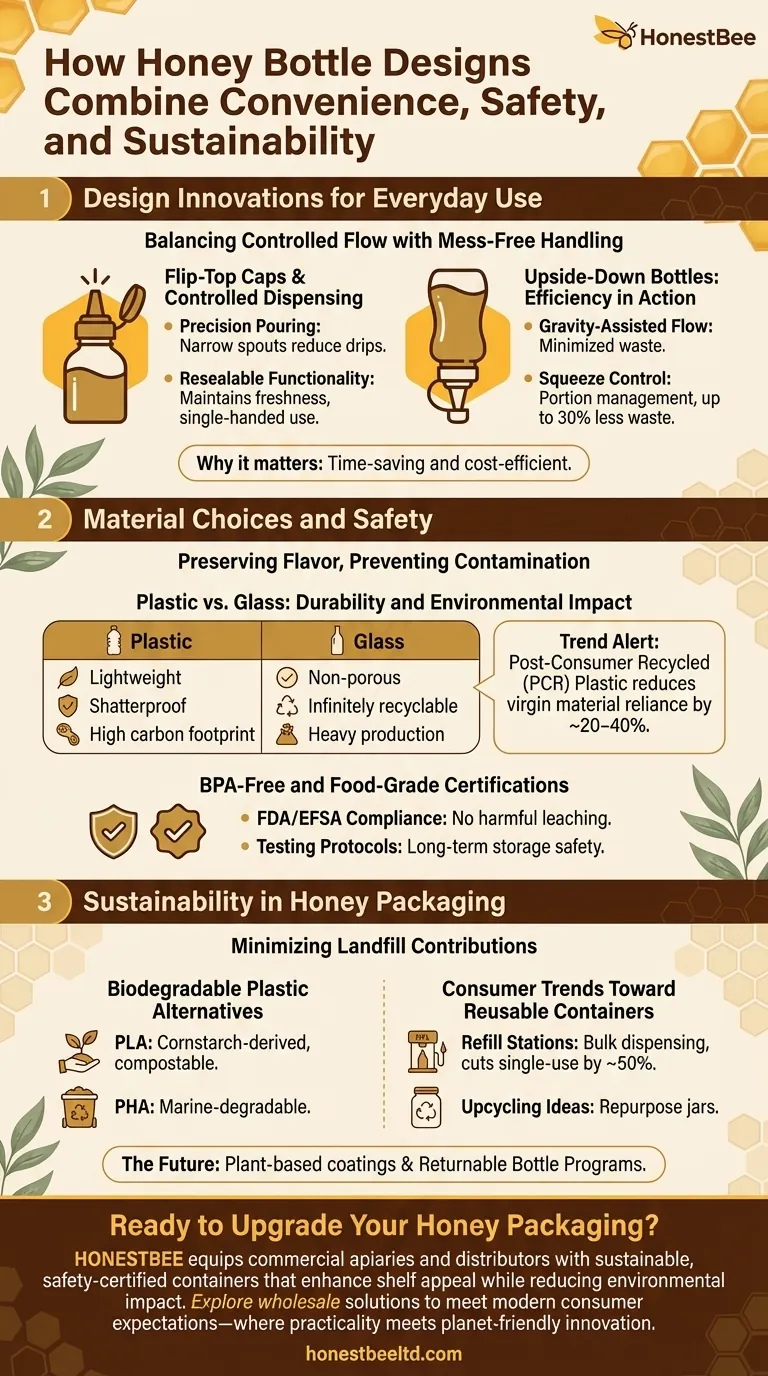Modern honey packaging solves three critical challenges: easy dispensing, material safety, and environmental responsibility. This article explores how innovative designs and materials meet consumer demands while protecting both product integrity and ecosystems.
Design Innovations for Everyday Use
Honey’s thick viscosity demands packaging that balances controlled flow with mess-free handling. Manufacturers now prioritize these features:
Flip-Top Caps and Controlled Dispensing
- Precision Pouring: Narrow spouts reduce drips, ideal for drizzling over foods.
- Resealable Functionality: Flip-top lids maintain freshness while allowing single-handed use—key for kitchens and on-the-go consumers.
Upside-Down Bottles: Efficiency in Action
- Gravity-Assisted Flow: Inverted designs let honey settle near the cap, minimizing waste and eliminating the need to scrape jars.
- Squeeze Control: Flexible bottles enable portion management, reducing over-pouring by up to 30% compared to rigid containers.
Why it matters: These designs cater to time-pressed users while cutting product waste—a win for convenience and cost-efficiency.
Material Choices and Safety
Honey’s acidic nature requires non-reactive materials to preserve flavor and prevent contamination.
Plastic vs. Glass: Durability and Environmental Impact
| Material | Pros | Cons |
|---|---|---|
| Plastic | Lightweight, shatterproof | Higher carbon footprint unless recycled |
| Glass | Non-porous, infinitely recyclable | Heavy, energy-intensive production |
Trend alert: Many brands now use post-consumer recycled (PCR) plastic, reducing reliance on virgin materials by ~20–40%.
BPA-Free and Food-Grade Certifications
- FDA/EFSA Compliance: Ensures plastics won’t leach harmful chemicals into honey.
- Testing Protocols: Migration tests simulate long-term storage to verify safety.
Did you know? Some beekeepers avoid crystallization-prone honey in certain containers, opting to feed it back to colonies—a natural solution that aligns with sustainable practices.
Sustainability in Honey Packaging
Eco-conscious consumers drive demand for packaging that minimizes landfill contributions.
Biodegradable Plastic Alternatives
- PLA (Polylactic Acid): Derived from cornstarch, compostable under industrial conditions.
- PHA (Polyhydroxyalkanoates): Marine-degradable, though costs remain ~2× traditional plastics.
Consumer Trends Toward Reusable Containers
- Refill Stations: Grocers like Whole Foods pilot bulk honey dispensers, cutting single-use packaging by ~50%.
- Upcycling Ideas: Brands encourage repurposing jars as spice holders or candle vessels.
The future: Expect more plant-based coatings and returnable bottle programs to emerge as circular economy models gain traction.
Ready to Upgrade Your Honey Packaging?
HONESTBEE equips commercial apiaries and distributors with sustainable, safety-certified containers that enhance shelf appeal while reducing environmental impact. Explore our wholesale solutions to meet modern consumer expectations—where practicality meets planet-friendly innovation.
Visual Guide

Related Products
- Hexagonal Glass Honey Jars with Metal Lug Caps Elegant Versatile Packaging
- Classic Drum Shaped Glass Honey Jar with Airtight Lid
- Inverted Squeezable Honey Jar with No Drip Flip Top Cap for Easy Pouring
- Classic Honey Bear Jars with Flip Top Dispensing Cap for Liquid Sweeteners
- Pneumatic Double Nozzle Honey Filling Bottling Packaging Machine
Related Articles
- How to Safely Restore Crystallized Honey Without Losing Nutrients
- The Hidden Threat After Harvest: Why a Simple Lid Prevents Apiary Disaster
- Mastering the Craft: A Professional's Guide to Calibrating Your Honey Refractometer
- How to Choose Honey Storage Containers That Prevent Spoilage and Extend Shelf Life
- How Honey Storage Science Preserves Nutrients: Temperature, Light & Container Insights




















